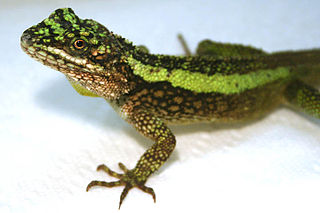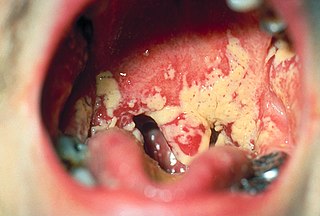
Streptococcus is a genus of gram-positive coccus or spherical bacteria that belongs to the family Streptococcaceae, within the order Lactobacillales, in the phylum Firmicutes. Cell division in streptococci occurs along a single axis, so as they grow, they tend to form pairs or chains that may appear bent or twisted. This differs from staphylococci, which divide along multiple axes, thereby generating irregular, grape-like clusters of cells. Most streptococci are oxidase-negative and catalase-negative, and many are facultative anaerobes.

The viridans streptococci are a large group of commensal streptococcal Gram-positive bacteria species that are α-hemolytic, producing a green coloration on blood agar plates. The pseudo-taxonomic term "Streptococcus viridans" is often used to refer to this group of species, but writers who do not like to use the pseudotaxonomic term prefer the terms viridans streptococci, viridans group streptococci (VGS), or viridans streptococcal species.

Streptococcus salivarius is a species of spherical, gram-positive, facultative anaerobic bacteria that is both catalase and oxidase negative. S. salivarius colonizes the oral cavity and upper respiratory tract of humans just a few hours after birth, making further exposure to the bacteria harmless in most circumstances. The bacteria is considered an opportunistic pathogen, rarely finding its way into the bloodstream, where it has been implicated in cases of sepsis in people with neutropenia,.

Streptococcus mutans is a facultatively anaerobic, gram-positive coccus commonly found in the human oral cavity and is a significant contributor to tooth decay. It is part of the "streptococci", an informal general name for all species in the genus Streptococcus. The microbe was first described by James Kilian Clarke in 1924.
Dental plaque is a biofilm of microorganisms that grows on surfaces within the mouth. It is a sticky colorless deposit at first, but when it forms tartar, it is often brown or pale yellow. It is commonly found between the teeth, on the front of teeth, behind teeth, on chewing surfaces, along the gumline (supragingival), or below the gumline cervical margins (subgingival). Dental plaque is also known as microbial plaque, oral biofilm, dental biofilm, dental plaque biofilm or bacterial plaque biofilm. Bacterial plaque is one of the major causes for dental decay and gum disease.

Diploderma splendidum, the green striped tree dragon, also called splendid japalure, is an agamid lizard found in the Yangtze River Basin of southwestern China. They are sold as pets internationally.
Streptococcus sanguinis, formerly known as Streptococcus sanguis, is a Gram-positive facultative anaerobic coccus species of bacteria and a member of the Viridans Streptococcus group. S. sanguinis is a normal inhabitant of the healthy human mouth where it is particularly found in dental plaque, where it modifies the environment to make it less hospitable for other strains of Streptococcus that cause cavities, such as Streptococcus mutans.

Streptococcus oralis is a Gram positive bacterium that grows characteristically in chains. It forms small white colonies on a Wilkins-Chalgren agar plate. It is found in high numbers in the oral cavity. It has been classified as a member of the Streptococcus mitis group. Members of this group are opportunistic pathogens. Strains of S. oralis produce neuraminidase and an IgA protease and cannot bind α-amylase.
Abiotrophia is a genus of lactic acid bacteria, a family in the phylum Firmicutes (Bacteria).

Oral microbiology is the study of the microorganisms (microbiota) of the oral cavity and their interactions between oral microorganisms or with the host. The environment present in the human mouth is suited to the growth of characteristic microorganisms found there. It provides a source of water and nutrients, as well as a moderate temperature. Resident microbes of the mouth adhere to the teeth and gums to resist mechanical flushing from the mouth to stomach where acid-sensitive microbes are destroyed by hydrochloric acid.
Veillonella are Gram-negative bacteria anaerobic cocci, unlike most Firmicutes, which are Gram-positive bacteria. This bacterium is well known for its lactate fermenting abilities. It is a normal bacterium in the intestines and oral mucosa of mammals. In humans they have been implicated in cases of osteomyelitis and endocarditis, for example with the species Veillonella parvula.
Veillonella parvula is a bacterium in the genus Veillonella. It is a normal part of the oral flora but can be associated with diseases such as periodontitis and dental caries as well as various systemic infections. It has also been isolated from women with bacterial vaginosis and has been associated with hypertension together with Campylobacter rectus and Prevotella melaninogenica.
Streptococcus constellatus is a species of Streptococcus that is part of the normal flora in the oral cavity, urogenital region, and intestinal tract. However, it can frequently cause purulent infections in other parts of the body. DNA homology studies and 16S rRNA sequence analysis demonstrate S. constellatus belongs to the Streptococcus anginosus group along with Streptococcus intermedius and Streptococcus anginosus.

The Streptococcus anginosus group (SAG), also known as the anginosus group streptococci (AGS) or the milleri group streptococci (MGS), are a group of several species of streptococci with clinical similarities. The group is named after a principal member species, Streptococcus anginosus. The older name Streptococcus milleri is now pseudotaxonomic, as the idea that these streptococci constituted a single species was incorrect. The anginosus group streptococci are members of the viridans streptococci group. They have been implicated as etiologic agents in a variety of serious purulent infections, but because of their heterogeneous characteristics, these organisms may be unrecognized or misidentified by clinical laboratorians. The unique characteristic of them from other pathogenic streptococci, such as S. pyogenes and S. agalactiae, is their ability to cause abscesses.
Streptococcus ratti is a species of Streptococcus. Streptococcus ratti can be viewed as a type of oral bacteria. It is a type of bacteria that may be found in healthy individuals. One example may be oral cavities. Streptococcus ratti is also a component of dental biofilms.
Streptococcus parasanguinis is a gram-positive bacterium of the genus Streptococcus that is classified as a member of the Streptococcus viridans group. S. parasanguinis is one of the major early colonizers of dental surfaces in the human oral cavity. Cell surface structures including pili and fimbriae allow the bacteria to adhere to oral surfaces. These adhesion molecules also play an important role in biofilm formation and promote aggregation with late tooth colonizers to form dental plaque. The presence of S. parasanguinis in the oral cavity is associated with a healthy microflora.
Well studied Periodontal pathogens are bacteria that have been shown to significantly contribute to periodontitis.
Corynebacterium matruchotii is a species of bacteria in the genus Corynebacterium. Corynebacteria occur within the normal flora of the human body.
Streptococcus cristatus is a species of viridans Streptococcus with tufted fibrils, first isolated from the human oral cavity and throat. The type strain is strain CR311.







